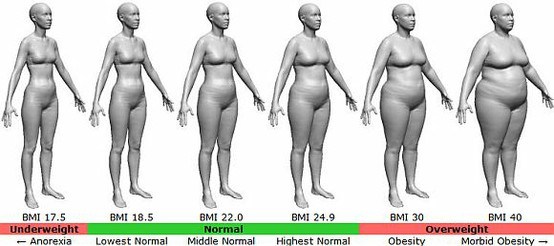BMI (body mass index) ûÊr ett mûËtt som anvûÊnds fûÑr att bedûÑma en individs hûÊlsa. Detta mûËtt utvecklades redan pûË 1800-talet och berûÊknas genom vikten (kg) / lûÊngd (m)2. Nackdelen med BMI ûÊr att det egentligen inte ûËterspeglar den metabola hûÊlsan sûÊrskilt vûÊl. I nya numret av Science diskuteras detta.
BegrûÊnsningarna med BMI som hûÊlsomûËtt blir uppenbara nûÊr man ser forskningsresultat av en uppmûÊrksammad studie som publicerades tidigare i ûËr i JAMA. Denna studie visade att ûÑverviktiga (men inte feta) personer lever lûÊngre ûÊn de med normal BMI. Det finns ûÊven en studie som visar att 25 % av de som har normal BMI hade metabola riskfaktorer medan 50 % av ûÑverviktiga inte hade denna typ av riskfaktorer.
Eftersom mûÊngden underhudsfett och var fettreserverna sitter ûÊr av betydelse diskuteras det om man istûÊllet bûÑr anvûÊnda midjemûËtt, midja-hûÑftkvot eller mûÊta fettprocent fûÑr att fûË en bûÊttre uppskattning om hûÊlsa. Men dessa mûËtt ûÊr inte heller perfekta och inte lika lûÊttillgûÊngliga som BMI.
Jag tycker dûÊrfûÑr att det ûÊr viktigt att framhûÊva fûÑrdelarna BMI ã det ûÊr extremt lûÊtt att uppskatta. Dessutom kan BMI ge en fingervisning om hûÊlsa, men mûËttet bûÑr nog tolkas tillsammans med annan information om t.ex. rûÑkstatus, alkoholkonsumtion, fysisk aktivitet och kosthûËllning.
BMI (body mass index) is a measure used to assess an individual’s health. This measure was developed in the 1800s and is calculated by weight (kg) / height (m) 2. The drawback with BMI is that it does not really reflect the metabolic health very well. This is discussed in the laterst issue of Science.
The limitations of BMI as a health measure becomes obvious when looking at research in an acclaimed study published earlier this year in JAMA. This study showed that overweight (but not obese) people live longer than those with normal BMI. There are also a study showing that 25% of those with normal BMI had metabolic risk factors and that 50% of overweight individuals were metabolically normal.
Since the amount of subcutaneous fat and location of fat reserves seem to be of importence it has been suggested that waist circumference, wast-to-hip ratio or measuring fat percentage would give a better reflection of health. But these measures are not perfect and more difficult to assess compared to BMI.
In conclusion, I think it is important to highlight the benefits of BMI – it’s extremely easy to assess. Additionally, BMI gives an indication of health, but the measure should probably be interpreted along with information such as smoking status, alcohol consumption, physical activity and diet.
